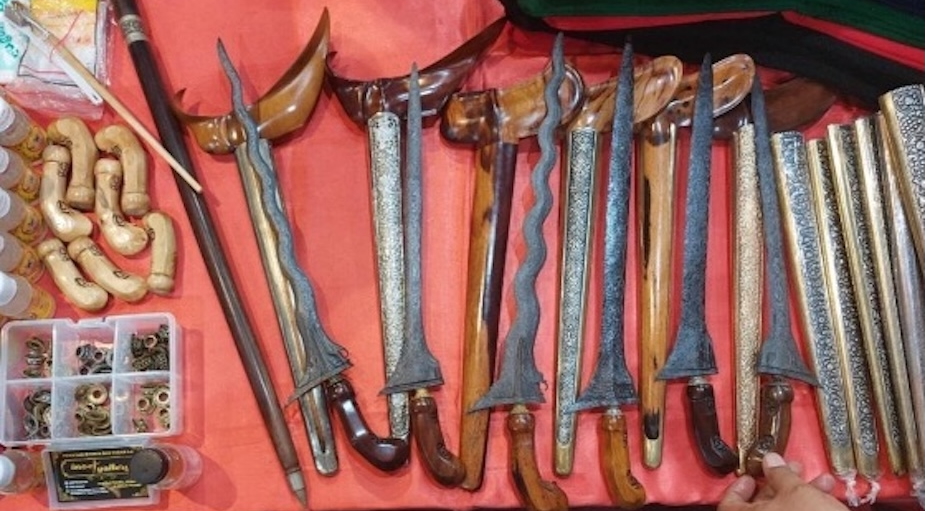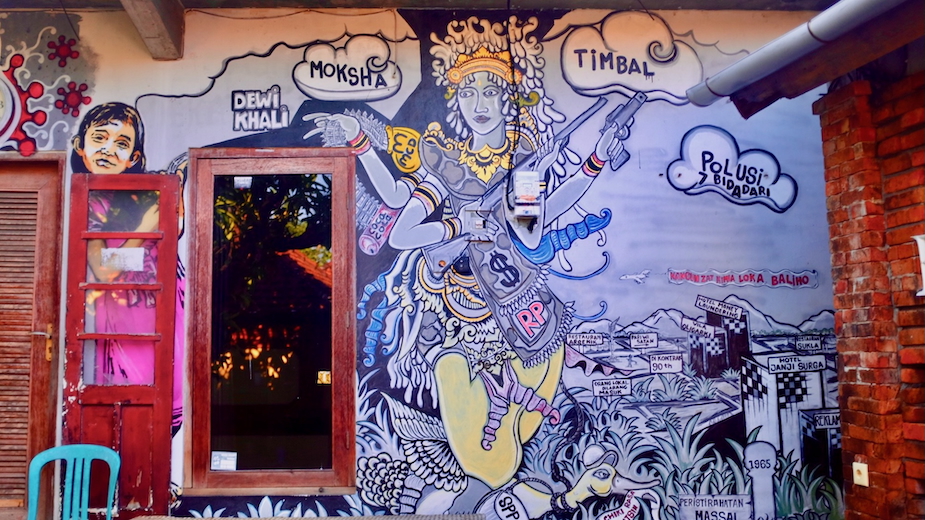A rowdy convention of Vespa enthusiasts shows the solidarity and inventiveness of Indonesian youth
Jenny McCallum
Scooters started to fill the square in front of the Kraton and Mesjid Agungon Saturday morning, and many stayed until the following afternoonJenny McCallum |
On a typical Saturday afternoon only a trickle of tourists file into the Kraton Kasunanan, the royal palace of Solo, and the dusty square of grass in front is inhabited only by goats, a few sellers of tacky souvenirs and the emblematic huge banyan trees. On one Saturday a few months ago however, the distinctive roar of thousands of antique engines could be heard even before you reached the gates. Walking in, you were hit by a riot of exhaust fumes, dreadlocks, alcohol and reggae.
The event was the twelfth anniversary of the ISSO (Ikatan Scooter Solo, or Solo Scooter Club), to which ‘scooterists’ from across the archipelago were invited. Over 2000 Vespas and owners arrived from as far away as Bali, Sulawesi and Kalimantan to congregate in front of the Kraton, lining up their scooters before taking a tour to admire the others on display. Some of the scooters were ordinary or even tired-looking, whilst others had been modified to impractical proportions, with elongated bodies or handlebars, or intricately tailored to match a particular theme such as military, American Indian or batik.
The owners, however, were largely less well-tended. The majority were scruffy young men in their twenties, many with dreadlocks and tattoos, who had not washed since they set off several days before, bringing only sleeping mats and helmets. On arrival, they celebrated with a stiff drink before unfurling their club flag and making ready to see and be seen. Many also took the opportunity to splash out on some of the accessories and spare parts on sale at the periphery of the area. For entertainment, a sound stage was set up where the results of competitions were announced. A concert of local reggae bands went on well into the night, and was received with enthusiastic dancing from the crowd. Those tired of dancing lay down in the front two pavilions of the palace or in makeshift camps, using scooters as tent poles, until they could rejoin the party.
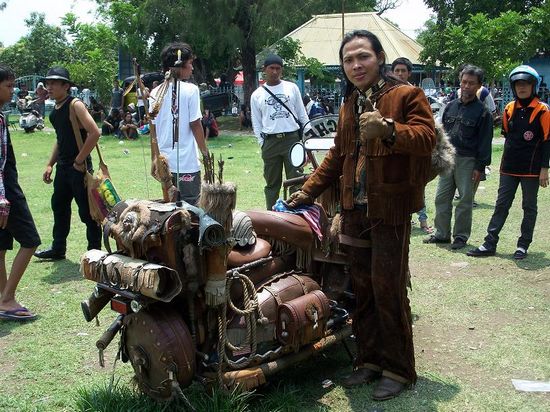 |
Owners often dress to match the style of their scootersJenny McCallum |
Insider culture
One might wonder how such a noisy, dirty, subcultural event came to be held at the city’s most important historical and tourist site. The explanation is simple: Bimo, grandson of King Pakubuwono XIII, is a core member of the Solo Scooter Club. His role also goes some way towards explaining the strikingly low police presence at an event where many of the vehicles might otherwise have been vulnerable to confiscation as a result of their owners’ lack of papers. Many participants themselves would also be at risk for not carrying their identity cards, if not for their appearance alone.
 |
Vespa road trippers are used to sleeping rough and are prepared for rain.Jenny McCallum |
Security at other music events in the city has been unusually high and seemingly designed to intimidate, since one young man was stabbed to death and two others injured at a large rock concert at the Sriwedari entertainment park in October 2009. Reza from the Solo Scooter Club organising committee saw it this way: ‘We have all the necessary permissions, I guess now they’re not that interested in us.’ Whether from luck or judgement, the lack of interest by the police suited the mood of the occasion, for the Vespa convention was no commercially sponsored event with an anonymous and therefore potentially dangerous crowd, but a meeting of ‘brothers’ who had come to celebrate and show solidarity rather than cause trouble.
 |
The Vespa and reggae scenes are closely linked due to their common aesthetic of freedom, fun and rebellion.Jenny McCallum |
Unity in diversity?
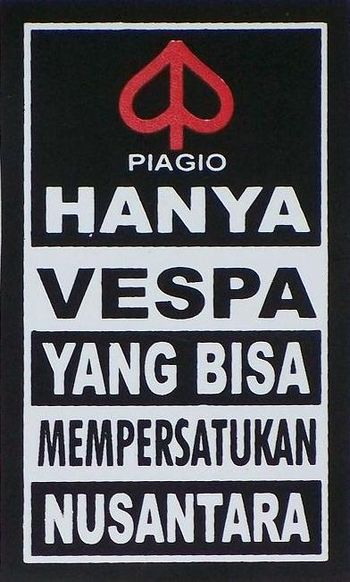 |
‘Only Vespas can unite the archipelago’Jenny McCallum |
Brotherhood is a defining feature of the scooter scene. Many of the vehicles sport stickers with slogans such as ‘One Vespa, a million brothers’ or ‘Only Vespas can unite the archipelago’. Scooter clubs, official or otherwise, have regular Saturday night hangout spots in towns and cities across Java and beyond. Enthusiasts spend long hours at specialist scooter garages, as the antique engines need regular maintenance. As Iwan from Solo cheekily remarked, ‘My Vespa is my first wife. She needs a lot of attention.’
Perhaps surprisingly, for the diehard fans Vespas are the vehicle of choice for road trips, with some travelling astounding distances. Some scooterists prefer to travel in large groups in case they break down, while others go it alone and rely on the strength of the scooter community. ‘I’m not worried on a Vespa, another scooter will always stop and help me if I break down,’ explained Budi from Sragen. ‘Sometimes a garage will even fix it for free.’
Despite the obvious importance of solidarity and belonging in the scooter scene, ‘uniqueness’ is often cited as the primary reason for the scooter’s appeal. Scooters have become a vehicle for the creativity of young Indonesians and are often modified in dramatic and surprising ways. Many fans adopt the gembel (junk/dirty) style using plastic bottles, rusted metal, rags, skulls and other found objects to make an impression without going to great expense.
Affordable style
There are other reasons for the scooter’s appeal. Many fans choose to continue the family tradition, having been taken for rides on their father’s Vespa since before they could walk. Others take advantage of the larger than average engine for drag racing: ‘They might be old, but they will always win.’ Overwhelmingly though, the most commonly cited reason is a gleeful chorus of ‘because they’re the cheapest!’ A second-hand Vespa can cost Rp.700,000 (A$80) or even less, placing them inside the realm of possibility for those who could not otherwise afford a motorbike. The gembel style, typically matched by the owner’s tattered style of dress, comes almost for free.
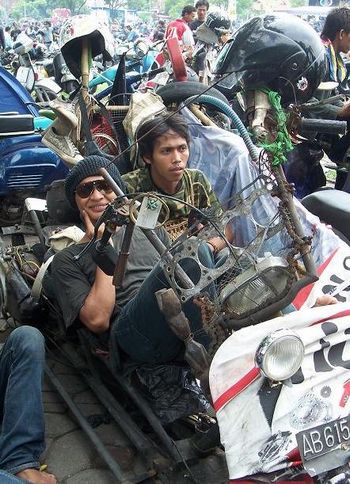 |
At the extreme, gembel-style scooters can be hard to recognise asvehicles.Jenny McCallum |
This fashion is in stark contrast with, and perhaps in reaction to, the opposite end of the market, where a well-maintained classic scooter from the 1950s or 60s can fetch up to Rp.40 million. This more presentable image of the Vespa frequently appears in contemporary Indonesian films, TV shows and advertising, as a symbol of freedom or to mark out a stylish and sophisticated character. At the palace gathering, people from the two ends of the spectrum coexisted peacefully and showed mutual respect for each others’ aesthetic.
 |
The gembel style is a way to make an impression without going to much expense.Jenny McCallum |
Under threat
The Vespa phenomenon is visible across Indonesia, with organised groups everywhere from major cities down to remote villages. Sadly, the scene has recently come under threat, not from official institutions but from private enterprise. Increasingly large numbers of scooters are being bought up, refitted and sold abroad through Bali at vastly inflated prices, presumably to countries where collectors can afford to pay high prices for vintage vehicles. Vespa clubs are starting to use the power of their brotherhood against this outside threat to try to prevent the sale of scooters to known exporters.
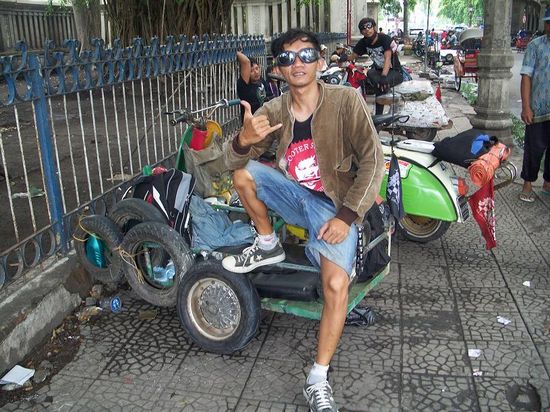 |
Ready for the next gathering of the scooterist fraternity.Jenny McCallum |
That weekend, though, as the party dispersed peacefully in a cloud of fumes on a rainy Sunday afternoon, many of the scooters were on their way not to Bali, but to Malang for the next in a chain of Vespa events. It should only be an eight-hour drive, and the event was in two weeks, but would they make it in time?
Jenny McCallum (jamjarjen@hotmail.com) is currently living in Solo, Central Java, experiencing as many kinds of music as possible.




